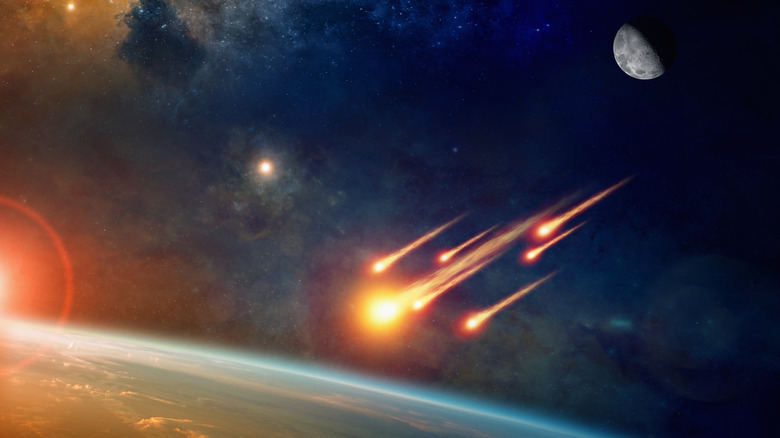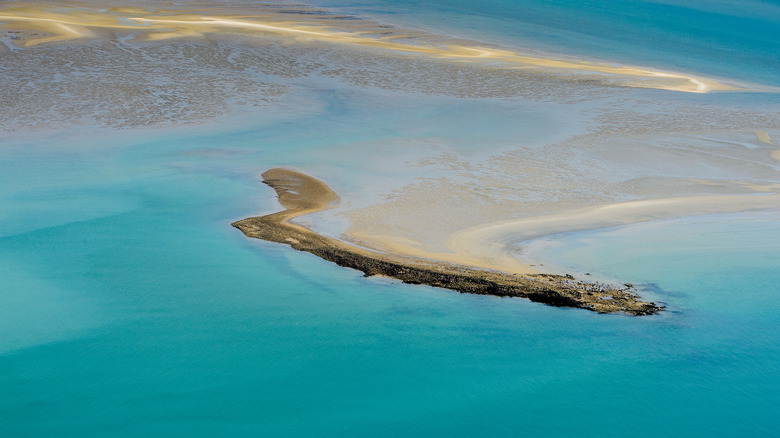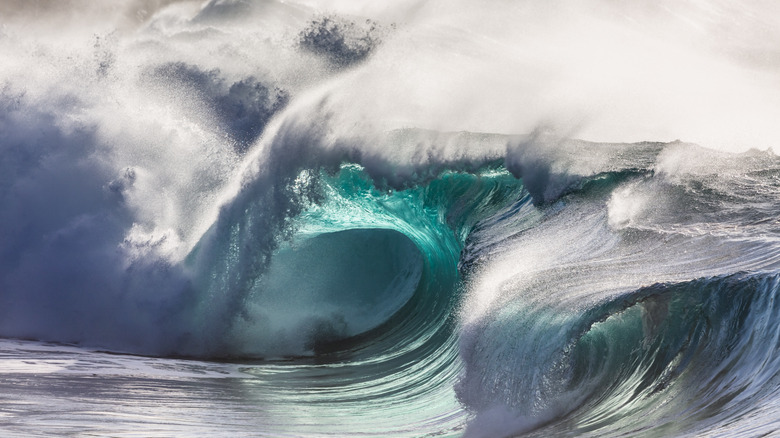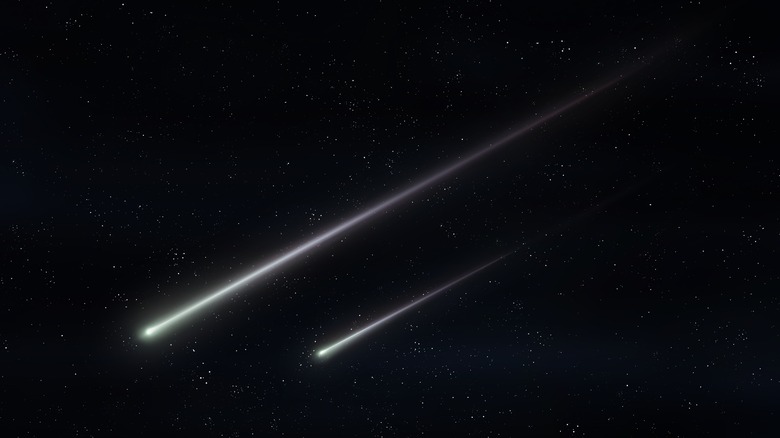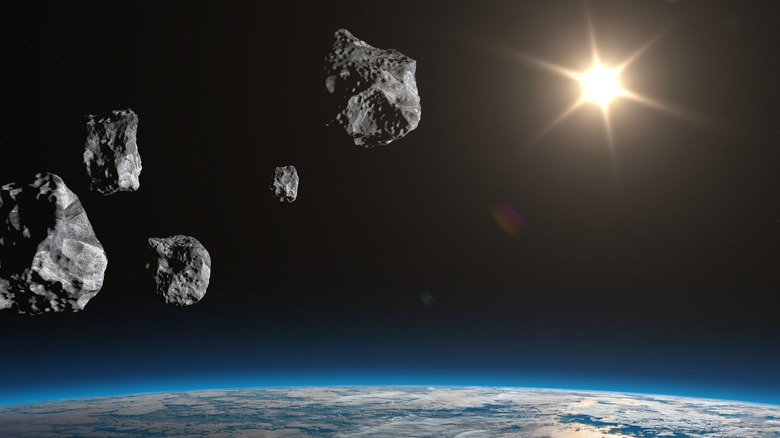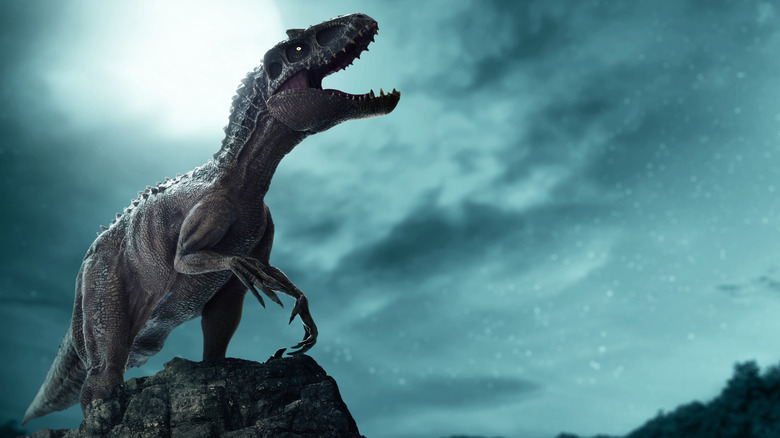The Asteroid That Killed The Dinosaurs Could Have Had A Companion
The story of the dinosaur-killing asteroid is getting a new chapter. Until recently, the prevailing theory for the demise of the dinosaurs focused on a single asteroid colliding with the Earth just off Mexico's Yucatan Peninsula (per the University of Arizona).
Modern scientists theorize that the asteroid's impact was world-changing. Evidence suggests that the asteroid measured 10 kilometers wide (a little over six miles), says Science News. According to Popular Mechanics, when the asteroid collided with the Earth, the impact created a 100-million-megaton blast, sparking a flash-like surge in temperatures, reaching as high as 10,000 degrees. The sudden heat caused massive wildfires, adds Smithsonian Magazine. The resulting fires "sent soot traveling all around the world," explains London History Museum's Professor Paul Barrett. "It didn't completely block out the Sun, but it reduced the amount of light that reached the Earth's surface. So it had an impact on plant growth," he said.
The soot covered the sky for 18 months, says Inverse. The near-constant nighttime wreaked havoc on the Earth's ecosystems, followed by a 5-10 year freeze. The initial blast and the following decade of environmental upheaval killed 75% of the Earth's species, including all nonbird dinosaurs (via ScienceNews). The asteroid left a massive crater named Chicxulub that runs along the Yucatan's northern coast and into the Gulf of Mexico. Chicxulub measures 90 miles wide and 12 miles deep, according to Space.com. Now researchers think that the asteroid may not have been alone.
An accidental discovery
On August 17, 2022, researchers announced that they'd made a surprising discovery 250 miles off the coast of West Africa — near Guinea and Guinea-Bissau. The geologist, Uisdean Nicholson of Heriot-Watt University in Edinburgh, had been studying the North Atlantic Ocean's floor, reports the University of Arizona. He and his team hoped to find information about the supercontinent's separation into the American and African continents (per ScienceNews). According to Popular Mechanics, Nicholson and his team used underground seismic wave data similar to ultrasound technology.
Instead, the data revealed a surprise lurking nearly 1,300 feet below the seabed's surface. The researchers realized they'd found the geological features of a large impact crater: a significant indent with an uneven surface that peaks in the middle. In Popular Mechanics, Nicholson explains how unusual such a discovery is, saying, "I've interpreted lots of seismic data in my time, but had never seen anything like this." Nicholson is surprised by his findings because underwater impact craters are incredibly rare, explains ScienceNews.
Scientists have identified only about 200 impact craters on the Earth (via Popular Mechanics). Making this discovery more surprising is that most known impact craters are on land. Underwater impact craters have a higher chance of getting swallowed by sediment, making the find highly unique. The researchers named the crater "Nadir" after the nearby Nadir Seamount, an underwater mountain, says the University of Arizona. Most intriguing are the possibilities for what Nadir could tell us.
Nadir's earth-shaking impact
Researchers theorize that the asteroid that created the Nadir crater would have been significantly smaller than Chicxulub's asteroid. However, Nadir's predicted size and impact remain impressive. The asteroid that caused the Nadir crater is estimated to have been around 400 meters wide. For reference, New York City's One World Trade Center is slightly over 400 meters tall (per Britannica). The sound from the asteroid's impact would have been louder than anything in human history (via The Conversation).
Additionally, the asteroid would have caused literal earth-shaking effects. Veronica Bray of the University of Arizona Lunar and Planetary Laboratory is the project's lead researcher and co-author. Bray described the impacts in Popular Mechanics: "This would have generated a tsunami over 3,000 feet high, as well as an earthquake of more than magnitude 6.5." For reference, a 3,000-foot tsunami would engulf the tallest building in the world, Dubai's Burj Khalifa, which reaches 2,716.5 feet high and 160 stories (per Burj Khalifa).
Adding to the intrigue around the newly discovered crater is its age. The study's three co-authors wrote in The Conversation that they dated the planet-altering Chicxulub crater and the Nadir within one million years of each other.
Were Chicxulub's and Nadir's asteroids related?
Nadir and Chicxulub appear on the top layers of the Earth that mark the end of the Cretaceous period, the last period of the nonbird dinosaurs on the planet, says Inverse. Though Nadir's asteroid and its impact were impressive, researchers do not think it played any significant role in the dinosaurs' extinction. As Veronica Bray explains to ScienceNews, if anything, Nadir's asteroid could have just made a bad situation a little worse. "The idea that [Chicxulub] had help — for want of a better phrase — would have really added insult to serious injury," she said.
Researchers are more interested in what Nadir could tell us about Chicxulub's origins and whether it was alone or a part of a larger asteroid cluster. Bray explains that the excitement surrounding Nadir rests in the questions its discovery raises. "If we have found one 'sibling' to Chicxulub, it opens the question: Are there others?" Bray told Popular Mechanics. Indeed, Uisdean Nicholson told Inverse that the Nadir crater may indicate that the two asteroids were a part of "an impact cluster at the end of the Cretaceous period." The Nadir crater could teach us more about what happens when asteroids hit the Earth — information that may help prevent a future catastrophic event.
What can Nadir teach us?
Researchers are eager to continue studying the Nadir crater. Veronica Bray's team has already announced their plans to drill around the Nadir crater get more information, says ScienceNews. These plans are notable because underwater impact craters are rare — scientists have located only 20 other craters like Chicxulub and Nadir. It is "exciting news whenever a new potential impact is discovered, especially in the hard-to-explore marine environment," says co-author Sean Gulick, an impact expert at the University of Texas at Austin (via Popular Mechanics).
One of the possible origins of both Nadir and Chicxulub could be a cluster of asteroids, all hitting the Earth around the same time. While scientists hypothesize that asteroids appear in clusters, there's little evidence on Earth to study. Uisdean Nicholson shares that scientists have found clues pointing to impact clusters on the moon dated to the Proterozoic era, before life on Earth. Per Inverse, he explains, "if confirmed, then the impact cluster hypothesis would have important implications for our understanding of the frequency and cascading environmental consequences of impact clusters in Earth's history."
Another possibility is that Nadir could have been a piece of Chixulub that had broken apart, says Popular Mechanics. Or, the co-authors explain in The Conversation, the two asteroids could be from the same "parent" or larger object, making them "siblings."
Could Nadir be something else?
Though there is much excitement surrounding the discovery of the Nadir crater, scientists caution that other possibilities for its origins are still on the table, reports ScienceNews. In the past, scientists thought they identified possible "siblings" of Chicxulub, such as Ukraine's Boltysh crater. Further analysis dated the Boltysh crater to several hundred thousand years later.
Alternative explanations for the Nadir crater include a collapsed volcano caldera or a salt diapir, similar in shape to an impact crater. The co-authors concede that an explosion caused by gas released from the ground could also have formed Nadir. However, they say that none of the alternatives are entirely consistent with the evidence on the ground (via The Conversation). Uisdean Nicholson says while he's taken the other theories into account, the crater's physical characteristics are strikingly different from that of a salt diapir or a collapsed caldera.
Veronica Bray emphasizes that there's still much more work to do and discoveries to be made (per Popular Mechanics): "These are preliminary simulations and need to be refined when we get more data." Regardless of the results, the Nadir crater has a story to tell that researchers are beginning to understand. Nicholson tells Inverse that Nadir has the potential to give us more details about the end of the Cretaceous period and the dinosaurs' extinction. "The more we find out about the event," he says, "the more of a complete picture we can build."
